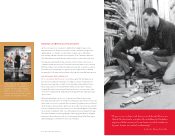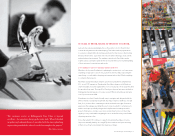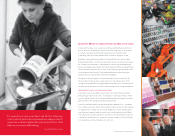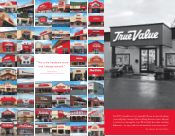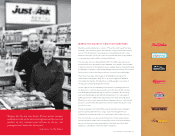True Value 2009 Annual Report Download - page 16
Download and view the complete annual report
Please find page 16 of the 2009 True Value annual report below. You can navigate through the pages in the report by either clicking on the pages listed below, or by using the keyword search tool below to find specific information within the annual report.
Management’s Discussion and Analysis
of Financial Condition and Results of Operation
2009 Financial Report 1
OVERVIEW
Fiscal year 2009 was a challenging year for True Value. The U.S.
economy was embroiled in arguably the worst recession since
the Great Depression. The unemployment rate rose from 7.4%
at the beginning of the year to 10.0% in December. Consumers
started to save more, almost 4% more compared to 2008 and they
started to pay down their debt, causing a reduction in dispos-
able income and a more value conscious consumer. Consumers
reduced their spending and so did most True Value members.
Members wisely became more cash flow minded resulting in more
conservative purchases from True Value. The weak housing and
construction industries also impacted our members’ contractor
business with less equipment and product purchases. All of these
factors put downward pressure on True Value’s revenue. Reve-
nue from members’ purchases in 2009 declined 9.4% compared
to 2008. Excluding the impact of the 53rd week in 2008, revenue
was down 8.5% on a comparable 52-week basis.
In spite of the revenue decline, True Value improved its finan-
cial position in 2009. Through extensive expense control and
enhanced inventory management, True Value increased its profit-
ability to $65,446 in 2009, from $64,228 in 2008 and $63,767 in 2007,
reduced its debt by 14%, increased cash-on-hand by $19,668 and
increased order fill rates to 96.0% compared to 95.6% in 2008. In
addition, True Value continued to make investments in strategic
initiatives and increased its level of program funding to members
for its new Destination True Value (“DTV”) store format. The DTV
format rolled out at a rate of one per week in 2009, comprised
of 25 remodels, 10 expansions or relocations and 17 new stores.
To date, on average, members have experienced a 10% revenue
increase after a DTV remodel. Even in light of the current eco-
nomic condition, with the current backlog of DTV projects, True
Value’s management anticipates to exceed that pace in 2010.
Management utilizes a variety of key performance measures to
monitor the financial health and performance of True Value’s
business. These measures are comparable store product sales
to members (“Comp Store Sales”) and net member attrition
(two drivers of Net revenue), gross margin percentage, oper-
ational/interest expense and debt levels. Recently, True Value
has begun to measure its members’ comparable store sales at
retail as approximately 1,500 core domestic members provided
daily point of sale data.
NET REVENUE ($ in millions)
% CHANGE IN COMP STORE PRODUCT SALES
% REVENUE INCREASE/DECREASE FROM
NET MEMBER ATTRITION
In 2009, Comp Store Sales continued to decrease and net mem-
ber attrition reverted back to lost Revenue from terminated stores
exceeding Revenue from new stores. The 2009 Comp Store Sales
reduction of 7.4% was primarily driven by the negative impact
of the economic recession and the one less week of revenue in
2009 compared to 2008. The one extra week was the result of
True Value’s reporting calendar. Fiscal year 2008 was a 53-week
reporting year and 2009 was a 52-week year. Excluding the impact
of the 53rd week, Comp Store Sales were down 6.3% in 2009.
Additional downward pressure was put on Comp Store Sales from
the compounding impact of members buying less product due
to lower consumer spending and the members conserving more
of their cash flow by bringing down inventory levels in order to
preserve cash during the economic recession. This is supported
by the members’ comparable store sales at retail, reported from
approximately 1,500 True Value core hardware members, being
down 2.8% on True Value-related stock keeping units (“SKUs”)
compared to True Value’s Comp Store Sales to all core hardware
members being down 5.4%.
True Value’s 2009 net member attrition was unfavorable by 2.5%.
The number of participating stores decreased to 4,905 from
5,140 at the end of 2008, driving revenue from terminated stores
to exceed revenue from new stores. Management attributes
this decline in net member attrition to the economic recession
and its related impact on the credit market as a number of
True Value’s existing and prospective members pursuing new
stores were unsuccessful or delayed in obtaining financing, even
with increased financial incentives from True Value.
2006 2007 2008 2009
$0
$700
$1,400
$2,100 $2,050 $2,041 $2,013
$1,823
2006 2007 2008 2009
-8.0%
-4.0%
0%
4.0%
1.6% 1.1%
-2.1%
-7.4%
2006 2007 2008 2009
0%
-1.5%
-3.0%
1.5%
-1.0% -1.2%
-2.5%
0.1%
($ in thousands)


